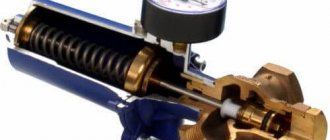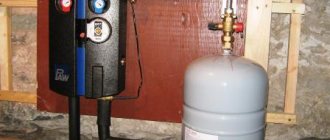Work to ensure the proper functioning of heating equipment does not end with its installation. Maintenance requires the owner to have a certain level of knowledge and constant monitoring of the condition of the system. It is important to understand why the pressure in a gas boiler drops or rises, which is why the equipment operates with fluctuations.
The article we presented describes in detail all the reasons for pressure instability in the coolant and hot water preparation system. We'll show you how to troubleshoot and keep your readings within normal range. Our recommendations will help you cope with emerging breakdowns and prevent operational failures.
What should be the pressure in the heating system?
Heating systems can be divided into two types - closed and open. When open, the pressure regulation function is performed by a leaky expansion tank.
The container is installed at the top point of the heating circuit and serves to hold the coolant expanding when heated, to remove air, and also acts as a safety valve. The operating pressure in such a system depends mainly on the temperature of the heating water.
Most often, when organizing heating in houses and apartments, closed heating systems are used. They are more effective and safe, but require constant pressure monitoring.
It is very important to monitor the pressure and temperature of the coolant, and respond to any signs that are not typical for the normal operation of the heating system - knocking, frequent discharge of hot water through the safety valve, cold sections of the circuit
The pressure in a closed-type circuit arises due to forced circulation carried out using a pump. Pressure deviations from the norm can lead to equipment failure.
The nominal pressure in gas boilers of different models may vary; it is determined by the technical characteristics of the equipment
When designing a heating system, the pressure is calculated taking into account the height of the water column, the length of the system, the characteristics of the connected equipment, and the cross-section of the pipes.
To adjust the working pressure, you need to focus on the following parameters:
- Technical characteristics of a gas boiler. The manufacturer indicates the capabilities of the equipment and its settings in the instructions.
- Coolant temperature. The higher the temperature, the greater the pressure in the circuit; as it decreases, it decreases. Therefore, setting and measuring the pressure in the gas boiler and heating circuit must be carried out before and after heating the coolant.
- Volume of the circuit and expansion tank. The size of the accumulator has a direct impact on the pressure in the heating circuit and the range of its fluctuation.
- Acceptable pressure indicators for the least “weak” element of the system. The pressure in the system should not exceed the permissible values for each of its elements. For example, polypropylene pipes, which on average are designed for a pressure of 25 bar at room coolant temperature, can withstand an increase in pressure only up to 7-9 bar at a temperature of 90 °C.
The minimum pressure in the circuit can be 0.5-0.8 bar, the exact standard values are indicated in the instructions, in accordance with them the pressure sensor is adjusted to the required value. If the pressure in the heating system drops below 0.5 bar, an emergency situation occurs, in which the gas boiler may stop or be damaged.
The highest pressure value in the system is up to 3, less often up to 4 bar. For a five-story building, pressure values are adjusted to 5 bar, for a ten-story building to 7 bar. When making settings, it is necessary to adhere to the difference in pressure between the outgoing and return pipes - it should be 0.3-0.5 bar. After starting the heating, check if this is the case.
Air pressure in the expansion tank of the vaillant boiler
A boiler is an indispensable piece of equipment that provides heat to the entire house or apartment. Today there are many manufacturers of gas boilers with a wide range of this equipment. Boiler models differ in their power, functionality and installation method. Unfortunately, even the most reliable and expensive boiler models are not immune to various types of breakdowns. Experts in this field analyzed failures of gas boilers and determined that the boiler often malfunctions because the pressure in the expansion tank is incorrectly set.
When organizing heating in your home, you can use different ideas. Recently, special demand has grown for a system that is characterized by a closed type. These systems are characterized by the movement of coolant using a pump, which ensures the forced movement of liquid in a closed loop. Using a gas burner, the water in the primary heat exchanger is heated. The pump, in turn, begins to pump liquid through the system with heating devices. After which the heat is transferred throughout the room.
To ensure proper operation of the coolant circulation, it is necessary to completely fill the system with water. In the heating system, pressure increases, which may have a detrimental effect on the integrity of the pipes, as well as on the installation itself. And since liquids tend to expand, it is necessary to somehow compensate for the increased volume.
What is the need for an expansion tank?
The expansion tank in the boiler serves as an additional reservoir and compensator for expansion that occurs during the heating process. To avoid a strong increase in pressure and to prevent the safety valve installed in three-atmosphere boilers from tripping, this expansion tank is necessary.
This tank is also needed to compensate for the pressure itself when the system cools down, so that it remains in a certain range suitable for stable operation of the boiler. So that it does not fall into the red zone and the boiler does not become blocked. The excess heated liquid gets there, and after cooling, the pressure returns to a stable level, and the liquid again enters the system through the pipes.
Signs that your blood pressure needs to be increased
During operation, the boiler must be under a certain excess pressure in the expansion tank. The user of this equipment is required to monitor this pressure, shown on the pressure gauge, which is located on the boiler itself. If the equipment is assembled correctly and there are no leaks, the pressure indicator should not drop. But sometimes, after a year or two years of operation of the boiler, the pressure in the boiler may drop or even the pressure may jump during the operation of the boiler when the burner starts working. Most often, in the absence of a visible leak, the cause of this behavior is an empty expansion tank.
A typical expansion tank used in boilers. Installed either at the back or side of the boiler
The pressure in the tank refers to the initial coefficient showing the pressure of the chamber with air in an empty tank at the temperature in the room. This pressure must fully correspond to the degree of static heating pressure after it is filled with coolant. This will provide the membrane with a state of equilibrium. The pressure level in the coolant will be compensated due to the gas pressure in the air chamber. In this case, the volume of the tank is not completely filled, so this volume will be sufficient to cover the liquid level, depending on thermal expansion.
The static pressure of 1 m of water column is approximately 0.1 atmospheres. It follows from this that the indicator of this pressure in the heating of an apartment or house will be less than 1 atmosphere.
In order for a gas boiler to operate stably and correctly, it is necessary that the coolant pressure level in a closed system is not less than the value specified in the boiler’s operating instructions.
During operation, it is necessary to check the pressure of the expansion tank and set its value corresponding to that specified in the instructions for use. One of the indicators of a devastated bank will be pressure surges. During operation of the boiler, the pressure begins to increase, and the boiler safety valve is triggered.
A reset occurs and after the burner turns off, the pressure begins to drop to almost zero. When you try to fill or refuel the boiler, the pressure readings on the pressure gauge return to normal. But the next time the burner is turned on, when heating begins to occur, the pressure readings jump again.
As a result, the safety valve is triggered again.
When checking the pressure in the tank, it is necessary to drain the water from the boiler. The heating circuit should be closed and the cold water supply should be closed. Water must be discharged through a special discharge device, using some kind of container for this. Connect the hose to the drain fitting. Using a 13mm wrench, unscrew the nut that secures the fitting. After this, the water gradually begins to drain from the boiler, as a result of which the pressure begins to decrease. Drain the water completely until the needle on the pressure gauge drops to 0.
To check the pressure in the expansion tank, you can use a tire pressure gauge, which is used to check the tire pressure in a car. Usually in boilers the expansion tank is installed in such a way that it is not even necessary to remove the lid from the boiler in order to pump it up.
The tank is most often located behind the combustion chamber and installed on the rear wall of the boiler. In order to get to it, we find the Schrader valve, closed with a cap, and remove it. Using a tire pressure gauge, we check the pressure in the expansion tank.
The lack of pressure in the expansion tank explains the jumps in pressure readings in the boiler. Therefore, it is necessary to pump up the pressure in the expansion tank
How to check the pressure in the boiler and circuit
System pressure is monitored using instruments that measure and display circuit pressure using a digital or mechanical dial. The sensors are installed by the manufacturer at the boiler outlet.
During the installation of the system, pressure gauges are also installed near the collectors, which distribute the coolant to various parts or floors of the building.
A safety group for boilers in the heating system helps control the temperature, pressure in the circuit, protects equipment from destruction by removing excess pressure outside
Additional pressure control is required when using boilers to heat water in underfloor heating systems. A drop or increase in pressure can be observed differently in different parts of the heating system.
A closed loop allows you to increase the pressure in the system, which increases its safety, since at higher pressure the boiling point of the liquid increases
When starting a gas boiler, check the pressure gauge while the heating water is still cold - the pressure should not be lower than the minimum value indicated by the red adjustable pressure gauge needle. The setup is carried out by a representative of the company with which a contract for service and gas supply has been concluded.
The initial setting is carried out when heating is started for the first time. In the future, the pressure is checked every week, and if necessary, the system is topped up with water. Make-up is carried out at a coolant temperature below 40 °C.
Reasons for the increase in pressure in a gas boiler
In addition to the pressure gauge readings, frequent discharge of water through the safety valve and blocking the operation of the device help to detect an increase in pressure in a gas boiler. Having determined high pressure, first of all, excess air is released through the Mayevsky taps and the boiler is turned off. There may be several reasons for malfunctions.
The normal upper pressure value is ensured by the system by discharging excess coolant through a safety valve into the drain
An increase in pressure in a gas boiler can be caused by damage to the partition of the secondary heat exchanger, which simultaneously serves to insulate and increase the contact area of two circuits - heating and hot water supply.
The secondary heat exchanger takes water from the heating circuit for preparing and supplying hot water in a double-circuit boiler. Damage to the partition leads to the forcing of water from the hot water circuit into the heating system, increasing the pressure in it.
The secondary heat exchanger serves to service the hot water supply system. Water for domestic hot water is heated as a result of contact with the coolant of the heating circuit. The system is protected from mixing the two circuits by a metal partition, damage to which leads to the exchange of liquids and disruption of normal pressure
Replacing the heat exchanger will solve the problem. You can carry out repairs yourself, but it is not advisable to do this, since interfering with the operation of gas equipment requires knowledge and experience in this area. In addition, repairing the boiler yourself will deprive you of the right to warranty service.
A malfunction of the automatic gas boiler or a loose pump impeller, which sucks in air, also increases the pressure in the gas boiler. Equipment malfunctions that lead to disturbances in normal pressure may be the result of a manufacturing defect, a breakdown of the control board, or an incorrectly configured system. Only a qualified technician can fix this kind of problem.
Conclusions and useful video on the topic
Pressure surges in a heating system with a double-circuit boiler:
Why does the pressure in the heating system drop:
Reasons for the increase in pressure in the heating circuit:
Instability of pressure in the heating system occurs due to its incorrect connection, non-compliance with operating rules, and the use of faulty devices.
Understanding the reasons for the drop and increase in pressure in a gas boiler helps to properly maintain the system, but this is not a reason to independently interfere with the operation of the equipment. For help, it is better to contact a specialist from a gas service that supplies blue fuel.
Other troubleshooting methods
Checking the parameters in the expander is included in the list of annual boiler maintenance. When air flows through the drain valve during the test, and the pressure gauge needle in the gas sector drops to atmospheric pressure, it means that the membrane in the tank is broken and needs to be replaced.
It is not recommended to glue the membrane together, since it works cyclically in tension/compression, which will cause repeated destruction of the glued joint, and at the most inopportune moment for the boiler.
Acceptable problems with the expansion tank:
- The needle on the pressure gauge in the heating system fluctuates greatly and has a high value even at low coolant temperatures due to the lack of air in the cavity - the expander needs to be pumped with air.
- The membrane is damaged - it needs to be replaced with an original one at a service center.
- The case is damaged, the integrity is restored at the service center.
- The air sector nipple is leaking - you need to blow out and pump the vessel with air.
- Small volume of the expander - you need to perform a new calculation and replace the device with a new modification.
- Coolant leakage from the vent due to damage to the membrane - it must be replaced with an original one at a service center.
- The coolant pressure is low, it does not flow to the upper point of the network, due to the lack of air (nitrogen) in the expander, the installation will need to be filled with air.
Thus, to summarize, it should be noted that the requirements for the operation of heating networks to compensate for the thermal expansion of the coolant in systems, both closed and open, require compensation for the temperature expansion of network water using expansion tanks.
They are pre-calculated for the technical characteristics of the in-house heating system. During operation, such devices must be periodically maintained and filled with a working agent: air or nitrogen.
Increasing pressure in the heating circuit
What to do if the pressure in the heating system rises excessively?
First of all, you need to establish the cause, and there may be several of them:
- Incorrect filling of the contour, its airiness. Due to the rapid filling of the heating line, air pockets may form in it. To avoid this phenomenon, when starting the heating, it must be filled slowly.
- The circuit temperature is too high. Any increase in temperature and coolant leads to its expansion and increased pressure in the system. It is necessary to prevent too high an increase in order to protect heating equipment from critical loads.
- Stopping the flow of coolant. The reason may be blocked shut-off valves, clogged mud filter, or air locks.
To identify the problem area, you need to examine the entire contour step by step.
The filter must be checked and cleaned immediately after the boiler is started for the first time, and then again a week later. Next, scheduled checks and cleanings are carried out once a month or season, depending on the degree of contamination of the coolant
Leaks can be caused by a breakdown of the make-up valve - wear of the valve gasket, mechanical damage to parts, or scale trapped between the seat and the gasket. If the tap is leaking, then excess water flowing from the water supply system into the heating main increases the pressure in it, because the pressure in the cold water pipeline is always higher. It is necessary to tighten the tap or replace it if it is faulty.
Air locks are a common cause of problems in the heating system. These can be caused by malfunctions of the gas boiler itself, problems in the circuit or incorrect starting of the heating.
Restarting the system will help troubleshoot problems - slowly filling it with coolant, starting from the lowest point, until water flows from the top point of the circuit. All air bleed valves must be open. Airing the system can lead to both an increase and a decrease in pressure.
The main reasons for low blood pressure
Common reasons why the pressure in a gas heating boiler drops are:
- Coolant leak. Damage to the heating line leads to a loss of tightness, loss of heating water and a decrease in pressure.
- Cracks in the heat exchanger. Leaks in the boiler itself will not only lead to a decrease in pressure, but can also provoke more serious equipment breakdowns and damage electronics.
- Rupture of the membrane in the expansion tank. Through damage to the rubber partition, liquid enters the air compartment and the pressure in the circuit decreases.
To determine the location of the leak in the system, it is fed to normal pressure and the circulation pump is stopped. Step by step, it is necessary to inspect the highway, identify the problem area and troubleshoot.
How does the operation of a hydraulic accumulator affect pressure?
Problems with the expansion tank that affect the pressure in the heating circuit are very common. Incorrectly calculated volume of the expansion tank is one of the most characteristic prerequisites.
Malfunctions can result from improper installation, low or high pressure in the air chamber of the tank, a damaged membrane - each of the reasons can lead to disruption of coolant circulation in the system.
Expansion tank: device features and volume
If a small volume tank is installed in the heating system, it cannot compensate for the expansion of heating water when heated. At a temperature of 85-95 °C, water expands by approximately 4% and its excess volume exits through the safety relief valve.
In order for the expanzomat to fully perform its compensatory function, its capacity for systems with a gas boiler must be at least 10 percent of the total volume of water in the circuit.
If you install a tank with a larger volume than normal, the pressure fluctuations will be even smaller. Reducing pressure differences has a positive effect on the operation of the system and the service life of heating equipment
Damage to the tank membrane leads to water completely filling its volume and the pressure in the circuit drops. If you fill the volume of the circuit by opening the make-up valve, this will create a new problem - when the coolant heats up, there will be no room for it to expand and the pressure in the system will increase more than normal. The situation can only be corrected by replacing the rubber partition.
The tank should only be installed on the return pipe, in front of the heating boiler. This way the tank will have minimal impact on the operation of the circulation pump, which is installed after the gas boiler. In addition, here the water temperature is lower and the negative impact on the pressure in the system and on the tank membrane will be less.
Setting the pressure in the air chamber
The pressure formed in the air chamber of the expansion chamber can also lead to an increase or decrease in pressure inside the heating system. You can check and pump up the air in the tank only if there is no coolant in the tank.
To do this, you need to shut off access to the common circuit using shut-off valves and drain the water through the drain. Then the pressure in the air chamber is measured and inflated/lowered to the required values.
You can check the pressure in the expansion tank using a car pressure gauge, and pump it up using a car pump.
To set the pressure of the expansion tank in the air chamber, it must be 0.5 bar higher than the expected maximum pressure in the system. After the pressure in the equalizing part of the tank is adjusted, fill the circuit with cold water to the expected pressure value.
Then the air is released from the air chamber until the pressure in the heating circuit and the tank begins to decrease simultaneously - here it is necessary to simultaneously monitor the pressure in the system and in the expansion tank.
In this phase, changes in indicators are little noticeable, so you must be prepared to immediately stop bleeding air from the expansion tank as soon as a simultaneous decrease is detected.
Vaillant gas wall boiler
An increase in pressure in the heating system is also possible due to the fact that:
- The shut-off valve is partially or completely blocked. As a result, the water supply pressure increases sharply and the boiler is blocked. It is necessary to open shut-off taps and valves, check the heating fittings for leaks;
- If a mechanical mud filter is installed, its mesh may become clogged with particles of rust, slag or sand. As a result, pressure rises in the boiler-filter section. Washing the filters will help relieve the coolant pressure. The simplest corner filter needs to be washed at least 3-4 times a year. Wash and magnetic filters are more expensive, but such devices purify water better and require cleaning only once a year;
- The make-up water tap is leaking or not “holding”. The pressure in the water supply network is in the range of 2.5 - 3.5 bar, that is, water will flow into the heating system, where the pressure is lower. This will inevitably lead to an increase in the volume of coolant. To solve the problems, you need to turn off or replace the make-up water valve. Most often, rubber gaskets become unusable and require replacement. As a temporary solution to the problem until the damaged parts are replaced, you can reset the indicators by completely shutting off the water supply to the double-circuit boiler;
- Malfunction of the boiler automation, failure of the thermostat or controllers. It is not always possible to determine why this happens. The reason may be manufacturing defects, the use of low-quality materials in the manufacture of the control board, incorrect installation, etc. You can fix the problem yourself if you know the error code and have the technical data sheet of the device. If the technical data sheet does not contain an error code and a method for eliminating it, you cannot do without a service department.
Why did the water pressure drop?
What affects the indicators in the circuit:
- The installation height of the housing, as a result - the height and length of the pipes.
- The effect of liquid on pipes and other elements.
- Construction of main tracks.
If your home has autonomous heating, then the standards depend on:
- Boiler models, pipeline paths.
- Installation locations.
- Number of floors in the building.
- Characteristics of the outer pipe.
Next we'll look at non-installation related reasons. If the device releases and does not gain pressure, this may be an internal failure or external factors.
Leak in the system
You add coolant to the circuit, but the pressure is still low. If the batteries heat up well, the moisture evaporates quickly, making the leak difficult to detect. Take a dry cloth and go over all pipe joints and connections. Look, there may be puddles accumulating under the radiators.
If the leak cannot be detected, use a compressor.
- Disconnect the radiators from the heating device.
- Drain off all liquid.
- Connect a compressor to the taps.
- Bleed the circuit with air.
- You will hear extraneous sounds in places where there is damage.
- To seal, use plumber's tow or sealant.
Incorrectly selected boiler - the power does not correspond to the established parameters of the pipeline. Therefore, the pressure constantly drops and does not hold.
If the values drop quickly, the cause may be the expansion tank. At the same time, you fill in the coolant every week, but it is becoming less and less, although no leaks have been detected. There is also a pressure drop in the mixers.
How to gain and improve performance:
- Turn off the water supply valves.
- Drain the circuit completely.
- Open the fitting on the expansion tank (RB) and record the numbers.
- Pump air until all the water comes out.
- Bleed the air and repeat the steps. Make sure that the needle on the pressure gauge does not exceed 1.3 bar.
- Open the taps and fill in the liquid.
If after the procedure the pressure drops and does not rise, inspect the membrane for damage. Replace if necessary.
Heat exchanger malfunction. After checking the pipes and connections, were there any violations found? Inspect the radiator for damage. A large accumulation of scale on the tubes leads to frequent flushing with reagents. This causes the material to quickly wear out and cracks to appear.
The bithermic unit cannot be repaired due to its design. Will need replacement. If a tubular radiator is installed, remove it. Fistulas can be detected by green spots on the surface. Dry the device and clean the damaged area with sandpaper. Then carry out soldering with a soldering iron or torch.
Problems with the water supply valve. When a faucet leaks, it leads to a constant drop in pressure. How to add coolant to the system? Only replacing the part will help.
Problems with the three-way valve. In dual-circuit devices, the valve serves to switch flows from heating to hot water supply. Clean the valve; scale and debris may interfere with its operation.
Airiness. It is not difficult to determine that there is an air pocket in the batteries. This is clear from the gurgling sounds where water collides with air. Do this:
- Record the pressure gauge values.
- Turn off the equipment.
- Place the container under the Mayevsky tap and open its valve.
- You will hear air moving and liquid may drip. Wait until the hissing stops.
- Turn on the water and supply it until the pressure gauge needle reaches the starting position. Turn off the taps.
- Start the boiler and listen to the operation. If sounds are heard again, repeat the procedure.










